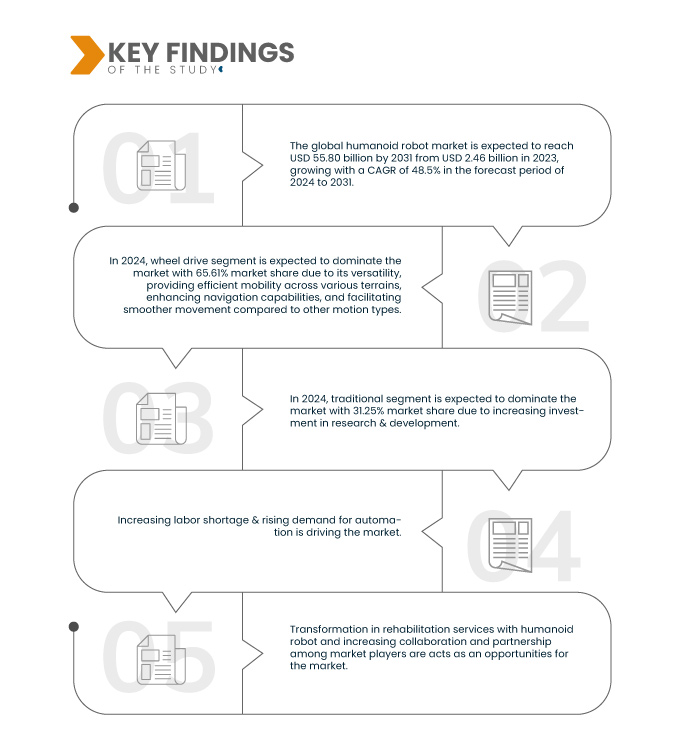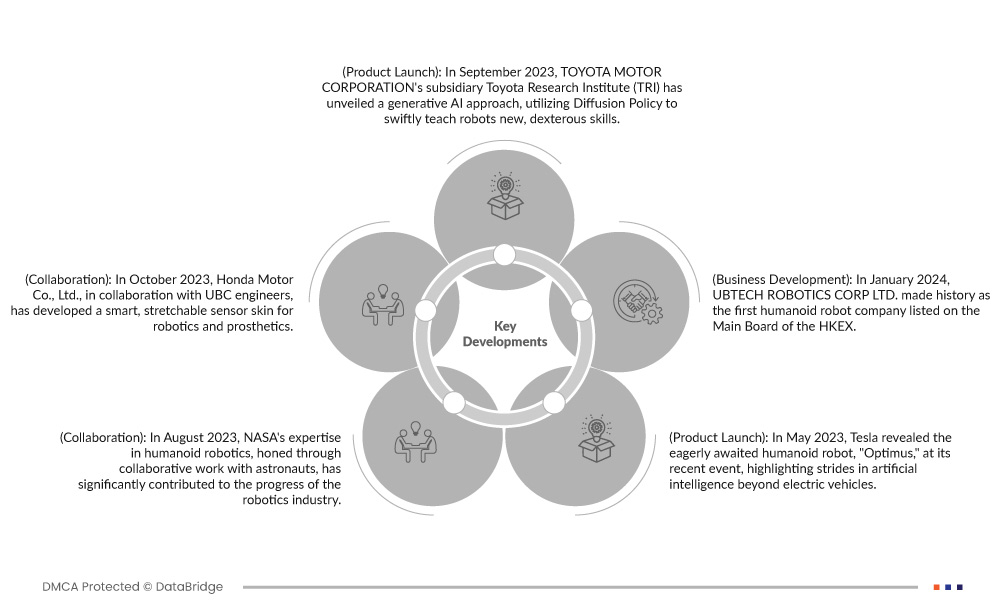A humanoid robot is a robot designed to resemble and mimic human behavior and appearance to varying degrees. It typically possesses a human-like structure with two arms, two legs, and a head, enabling it to interact with its environment in a way similar to humans. The global humanoid robot market encompasses the production, distribution, and utilization of these robots across diverse industries such as healthcare, manufacturing, entertainment, and research, catering to applications ranging from assistance and companionship to advanced industrial automation.
Access full Report @ https://www.databridgemarketresearch.com/reports/global-humanoid-robot-market
Data Bridge Market Research analyses that the Global Humanoid Robot Market is expected to reach a value of USD 55.80 billion by 2031 from USD 2.46 billion in 2023, growing at a CAGR of 48.5% during the forecast period from 2024 to 2031.
Key Findings of the Study
Increasing Labor Shortage and Rising Demand for Automation
The global manufacturing hubs, industries, warehouses, and other sectors have experienced a significant shortage of skilled workers. At the same time, there has been an increase in demand for automation solutions as businesses seek to improve efficiency, productivity, and adaptability to changing market conditions. This paradigm change has accelerated the growth of the global humanoid robot market, with humanoid robots appearing as an options to fill the gap caused by the growing labor shortage. The parallel growth of labour shortages and the demand for automation has positioned humanoid robots as a pivotal solution for businesses worldwide. As industries work to adapt to the evolving economic landscape, the global humanoid robot market is positioned to witness an exponential growth.
Report Scope and Market Segmentation
|
Report Metric
|
Details
|
|
Forecast Period
|
2024 to 2031
|
|
Base Year
|
2023
|
|
Historic Years
|
2022 (Customizable from 2016-2021)
|
|
Quantitative Units
|
Revenue in USD Billion
|
|
Segments Covered
|
Motion Type (Wheel Drive and BIPED), Technology (Traditional, Computer Vision, AI & ML, Natural Language, Deep Learning, Neural Network, and Others), Functionality (Perception & Sensing, Human Interaction & Communication, Mobility & Navigation, Learning and Adaption, Manipulation and Grasping, Autonomous Decision Making, and Others), Application (Inspection, Maintenance & Material Handling, Research & Space Exploration, Personal Assistance & Caregiving, Security and Surveillance, Search and Rescue, and Others), End User (Manufacturing, Healthcare, Research & Education, Hospitality, Retail, Entertainment and Gaming, Agriculture, BFSI, and Others)
|
|
Countries Covered
|
U.S., Canada, Mexico, Germany, France, U.K., Italy, Spain, Russia, Turkey, Belgium, Netherlands, Norway, Finland, Denmark, Sweden, Poland, Switzerland, Rest of Europe, China, Japan, India, South Korea, Australia, Singapore, Thailand, Malaysia, Indonesia, Philippines, Taiwan, Vietnam, New Zealand, Rest of Asia-Pacific, Brazil, Argentina, Rest of South America, South Africa, Saudi Arabia, U.A.E., Egypt, Israel, Oman, Bahrain, Kuwait, Qatar, and Rest of Middle East and Africa
|
|
Market Players Covered
|
TOYOTA MOTOR CORPORATION (Japan), Honda Motor Co., Ltd. (Japan), NASA (U.S.), Tesla (U.S.), UBTECH ROBOTICS CORP LTD (China), Agility Robotics (U.S.), APPTRONIK (U.S.), Beyond Imagination (U.S.), Boston Dynamics (U.S.), Engineered Arts Ltd (U.K.), Figure (U.K.), HANSON ROBOTICS LTD. (Hong Kong), Invento Research Inc (U.S.), KAWADA TECHNOLOGIES, Inc. (Japan), Macco Tecnología para el ocio, S.L. (Spain), PAL Robotics (Spain), promobot (U.S.), Sanctuary Cognitive Systems Corporation (Canada), and SoftBank Robotics America, Inc. (Japan) among others |
|
Data Points Covered in the Report
|
In addition to the insights on market scenarios such as market value, growth rate, segmentation, geographical coverage, and major players, the market reports curated by the Data Bridge Market Research also include in-depth expert analysis, geographically represented company-wise production and capacity, network layouts of distributors and partners, detailed and updated price trend analysis and deficit analysis of supply chain and demand
|
Segment Analysis
The global humanoid robot market is segmented into five notable segments into, motion type, technology, functionality, application, and end user.
- On the basis of motion type, the global humanoid robot market is segmented into wheel drive, and BIPED
In 2024, wheel drive segment is expected to dominate the Global Humanoid Robot Market
In 2024, wheel drive segment is expected to dominate the market with the market share of 65.61% due to its versatility, providing efficient mobility across various terrains, enhancing navigation capabilities, and facilitating smoother movement compared to other motion types.
- On the basis of technology, the global humanoid robot market is segmented into traditional, computer vision, AI and ML, natural language, deep learning, neural network, and others
In 2024, traditional segment is expected to dominate the Global Humanoid Robot Market
In 2024, traditional segment is expected to dominate the market with the market share of 31.25% due to its extensive experience, established infrastructure, and proven track record, which instills trust and confidence among consumers and investors.
- On the basis of functionality, the global humanoid robot market is segmented into perception and sensing, human interaction & communication, mobility & navigation, learning and adaption, manipulation and grasping, autonomous decision making, and others. In 2024, perception and sensing segment is expected to dominate the market with 30.05% market share
- On the basis of application, the global humanoid robot market is segmented into inspection, maintenance & material handling, research & space exploration, personal assistance & caregiving, security and surveillance, search and rescue, and others. In 2024, the inspection, maintenance & material handling segment is expected to dominate the market with 30.39% market share
- On the basis of end user, the global humanoid robot market is segmented into manufacturing, healthcare, research & education, hospitality, retail, entertainment and gaming, agriculture, BFSI, and others. In 2024, the manufacturing segment is expected to dominate the market with 32.37% market share
Major Players
Data Bridge Market Research analyzes TOYOTA MOTOR CORPORATION (Japan), Honda Motor Co., Ltd. (Japan), NASA (U.S.), Tesla (U.S.), UBTECH ROBOTICS CORP LTD. (China) as the major players in the global humanoid robot market.
Market Developments
- In January 2024, NASA successfully tested Valkyrie, a humanoid robot weighing 136 kilograms and standing at 188 centimeters tall, at the Johnson Space Center in Houston, Texas. Named after Norse mythology, Valkyrie is designed to operate in damaged environments, such as those affected by natural disasters. NASA envisions humanoid robots like Valkyrie playing a crucial role in future space missions, with engineers highlighting their potential to work similarly to humans using the right software and tools. This benefited company save lifes of their employees and focus them on other important work, which increase company overall productivity
- In January 2024, UBTECH ROBOTICS CORP LTD made history as the first humanoid robot company listed on the Main Board of the HKEX. The ground breaking move solidifies their position as pioneers in the industry, marking a significant milestone for humanoid robotics in the financial market. This benefited company by achieving commercialization of humanoid robots
- In September 2023, TOYOTA MOTOR CORPORATION's subsidiary Toyota Research Institute (TRI) has unveiled a generative AI approach, utilizing Diffusion Policy to swiftly teach robots new, dexterous skills. This milestone, achieved without writing new code, enhances robot utility, marking a significant stride towards creating "Large Behavior Models (LBMs)" for robots. TRI aims to impart hundreds of new skills by the year's end and an impressive 1,000 by the close of 2024, leveraging this transformative technology
- In October 2023, Honda Motor Co., Ltd., in collaboration with UBC engineers, has developed a smart, stretchable sensor skin for robotics and prosthetics. The innovative soft sensor, sensitive and pliable like human skin, enhances touch sensitivity and dexterity in prosthetic and robotic applications. This technology paves the way for safer and more lifelike human-robot interactions, opening new possibilities for advancements in the field
- In May 2023, Tesla revealed the eagerly awaited humanoid robot, "Optimus," at its recent event, highlighting strides in artificial intelligence beyond electric vehicles. Elon Musk expressed optimism about the robot industry's potential surpassing Tesla's automotive success. He acknowledged existing humanoid robots' limitations, lacking advanced AI for independent navigation. This benefited company to boost its image in robot market
Regional Analysis
Geographically, the countries covered in the global humanoid robot market are U.S., Canada, Mexico, Germany, France, U.K., Italy, Spain, Russia, Turkey, Belgium, Netherlands, Norway, Finland, Denmark, Sweden, Poland, Switzerland, rest of Europe, China, Japan, India, South Korea, Australia, Singapore, Thailand, Malaysia, Indonesia, Philippines, Taiwan, Vietnam, New Zealand, rest of Asia-Pacific, Brazil, Argentina, rest of South America, South Africa, Saudi Arabia, U.A.E., Egypt, Israel, Oman, Bahrain, Kuwait, Qatar, and rest of Middle East and Africa.
As per Data Bridge Market Research Analysis:
North America is expected to be the dominant region the Global Humanoid Robot Market
North America is expected to dominate the global humanoid robot market due to robust research funding, innovative technology hubs, and a culture fostering entrepreneurship and collaboration, resulting in cutting-edge advancements.
Asia-Pacific is expected to be the fastest-growing region in the Global Humanoid Robot Market
The Asia-Pacific region is expected to be the fastest growing region in the global humanoid robot market due to rapid technological advancements and extensive investment in automation across industries, driving robust demand for humanoid robots and fostering innovation.
For more detailed information about the Global Humanoid Robot Market report, click here – https://www.databridgemarketresearch.com/reports/global-humanoid-robot-market












